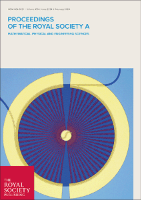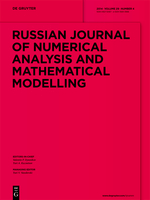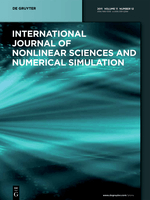
INTERNATIONAL JOURNAL OF MODERN PHYSICS C
Scope & Guideline
Connecting Scholars to the Latest in Physics Research
Introduction
Aims and Scopes
- Computational Physics:
A core focus of the journal is on computational methods in physics, including numerical simulations and modeling techniques that address complex physical phenomena. - Complex Networks:
The journal frequently publishes research on the structure and dynamics of complex networks, including their mathematical modeling, synchronization, and optimization in various contexts. - Epidemiological Modeling:
There is a significant emphasis on modeling infectious diseases and social dynamics, exploring the spread of epidemics through mathematical frameworks and computational simulations. - Fluid Dynamics and Heat Transfer:
Research on fluid dynamics, particularly in nanofluids and complex flows, is prevalent, with studies often employing advanced numerical techniques to investigate heat transfer and fluid behaviors. - Mathematical Physics:
The journal covers various aspects of mathematical physics, including the application of mathematical models to understand physical systems, phase transitions, and critical phenomena. - Machine Learning and Data Science:
Recent trends indicate a growing integration of machine learning techniques in analyzing complex datasets and optimizing models, highlighting the journal's commitment to advancing computational approaches.
Trending and Emerging
- Artificial Intelligence in Physics:
There is an increasing trend in the application of artificial intelligence and machine learning techniques to solve complex problems in physics, enhancing predictive capabilities and model optimizations. - Interdisciplinary Research:
Research that combines physics with fields such as biology, economics, and social sciences is on the rise, reflecting a broader interest in understanding complex systems across disciplines. - Advanced Numerical Methods:
Emerging themes include the development and application of advanced numerical methods, such as hybrid approaches combining different computational techniques to tackle complex simulations. - Resilience and Robustness of Networks:
The study of the resilience and robustness of networks, particularly in the context of cascading failures and interdependent systems, has gained prominence, highlighting the importance of network stability. - Epidemic Dynamics Analysis:
The journal has seen a surge in research related to epidemic dynamics, especially in light of global health challenges, utilizing mathematical models to understand and control disease spread.
Declining or Waning
- Quantum Computing Applications:
Although quantum computing remains a vibrant field, specific applications within the journal have decreased, possibly due to the rapid evolution of the field and the emergence of more specialized journals. - Traditional Statistical Mechanics:
Research focused solely on classical statistical mechanics has diminished, as interdisciplinary approaches incorporating modern computational techniques gain traction. - Static Theoretical Models:
There appears to be a waning interest in purely theoretical models that do not incorporate computational or empirical validation, as the field moves towards more dynamic and applicable studies. - Conventional Fluid Dynamics Studies:
There is a noticeable reduction in conventional fluid dynamics research without the integration of nanofluids or advanced computational techniques, reflecting a shift towards more complex and interdisciplinary studies. - Simplicity in Model Design:
Research that relies on overly simplistic models without considering complex interactions or real-world applications has become less common, as the journal encourages more nuanced and sophisticated approaches.
Similar Journals

SIAM JOURNAL ON APPLIED MATHEMATICS
Fostering Dialogue in the World of Applied MathematicsSIAM Journal on Applied Mathematics, published by SIAM Publications, is a leading academic journal that has been an essential resource for researchers and practitioners in the field of applied mathematics since its inception in 1969. With an impressive impact factor that places it in the Q1 category for Applied Mathematics and a respectable Scopus rank of #172 out of 635, this journal serves as a vital platform for sharing innovative research, methodologies, and applications that bridge theoretical mathematics and practical problems across diverse industries. Although the journal does not currently offer open access options, it remains a cornerstone of mathematical literature in the United States and worldwide, featuring rigorous peer-reviewed articles that address critical issues and advancements in the field. Researchers, professionals, and students are encouraged to engage with its rich repository of knowledge and contribute to the ongoing dialogue in applied mathematics, making it a must-subscribe journal for anyone invested in this dynamic discipline.

Proceedings of the Romanian Academy Series A-Mathematics Physics Technical Sciences Information Science
Catalyzing Discoveries in Engineering and Computer ScienceProceedings of the Romanian Academy Series A-Mathematics Physics Technical Sciences Information Science, published by EDITURA ACAD ROMANE, is a noteworthy academic journal that serves as a platform for disseminating original research in the intersecting fields of mathematics, physics, engineering, and computer science. With an ISSN of 1454-9069, this journal not only highlights the vibrant academic contributions from Romania but also attracts international submissions, thus fostering global collaboration. Though it currently does not offer an open-access model, the journal remains indexed in significant databases, reflecting its commitment to quality and scholarly rigor. The journal’s impact can be seen through its rankings, including Q4 in Computer Science, Q3 in Engineering, and Q4 across Mathematics and Physics, as well as its Scopus percentile rankings, which indicate meaningful contributions to these domains. With a converged publication span from 2008 to 2024, it aims to catalyze advancements in technical sciences while enriching the academic discourse among researchers, professionals, and students alike. The journal’s headquarters in Bucharest, Romania, positions it as a key player in the Eastern European academic landscape, making it essential reading for those engaged in cutting-edge research.

Eurasian Journal of Mathematical and Computer Applications
Fostering Interdisciplinary Insights in Mathematical Applications.Eurasian Journal of Mathematical and Computer Applications, published by the prestigious L N GUMILYOV EURASIAN NATIONAL UNIVERSITY in Kazakhstan, stands as a vital platform for researchers and professionals engaging in the fields of Applied Mathematics, Computational Mathematics, Computer Science Applications, Information Systems, Mathematical Physics, and Modeling and Simulation. With its ISSN 2306-6172 and E-ISSN 2308-9822, this academic journal aims to foster innovative research and facilitate knowledge transfer in these interdisciplinary domains. The journal, which converges its endeavors from 2013 to 2024, is currently ranked Q3 across its various categories in 2023, reflecting its growing influence and commitment to academic excellence. Despite its open access availability, the journal's dedication to quality research is evident as it attracts contributions that not only advance theoretical understanding but also address practical applications. With a supportive community of researchers in an increasingly important field, the Eurasian Journal of Mathematical and Computer Applications is poised to remain a significant resource for those seeking to propel the boundaries of mathematical and computational sciences.

PROCEEDINGS OF THE ROYAL SOCIETY A-MATHEMATICAL PHYSICAL AND ENGINEERING SCIENCES
Championing Quality Research in the Heart of Scientific Inquiry.PROCEEDINGS OF THE ROYAL SOCIETY A-MATHEMATICAL PHYSICAL AND ENGINEERING SCIENCES is a prestigious academic journal published by the Royal Society in the United Kingdom, dedicated to the dissemination of high-quality research in the fields of Mathematics, Engineering, and Physics. With an esteemed impact factor and ranked in the top quartiles (Q1) across various categories, this journal stands out as a leading source of innovative findings and critical discussions within the global scientific community. Researchers benefit from its comprehensive coverage that spans from theoretical explorations to practical applications, and the journal plays a crucial role in advancing knowledge and fostering interdisciplinary collaboration. Although it does not currently offer Open Access options, its influence is underscored by notable Scopus rankings, evidencing its significant contribution to the fields it represents. Located at 6-9 Carlton House Terrace, London SW1Y 5AG, England, the journal continues to be a cornerstone for scholars seeking to publish impactful research and stay informed on the latest advancements in science and engineering.

RUSSIAN JOURNAL OF NUMERICAL ANALYSIS AND MATHEMATICAL MODELLING
Advancing the Frontiers of Numerical Analysis and Mathematical InsightRUSSIAN JOURNAL OF NUMERICAL ANALYSIS AND MATHEMATICAL MODELLING, published by WALTER DE GRUYTER GMBH in Germany, is a vital resource for researchers and practitioners in the fields of numerical analysis, mathematical modeling, and computational mathematics. With an ISSN of 0927-6467 and an E-ISSN of 1569-3988, this journal has been disseminating significant findings since its inception in 1986 and continues to do so into 2024. Despite its current position in Q4 category quartiles and modest Scopus rankings, it provides a platform for innovative research that contributes to the evolution of modeling and simulation techniques. The journal is committed to fostering an understanding of complex numerical methods and their applications across various scientific disciplines. Although it does not provide Open Access options, it remains a key publication that underscores the importance of rigorous mathematical analysis and its practical implications in today's technology-driven world.

Computational and Mathematical Methods
Innovating Solutions Through Computational InsightsComputational and Mathematical Methods is a dynamic peer-reviewed journal published by Wiley-Hindawi, focusing on innovative research in the fields of computational mathematics, mechanics, and theory. Since its transition to an Open Access format in 2022, the journal has enhanced its accessibility to researchers and practitioners globally, providing a platform for the dissemination of high-quality studies that contribute to emerging developments in mathematical modeling and computational techniques. Based in the United Kingdom, this journal is committed to fostering collaboration amongst scholars, evidenced by its rankings within Scopus: Q3 in computational mathematics, computational mechanics, and computational theory and mathematics, reflecting its relevance and influence within these critical fields. With an emphasis on interdisciplinary studies, Computational and Mathematical Methods is an essential resource for researchers, professionals, and students seeking to expand their knowledge and apply cutting-edge methodologies to practical challenges.

INTERNATIONAL JOURNAL OF NONLINEAR SCIENCES AND NUMERICAL SIMULATION
Elevating Nonlinear Sciences to New HeightsINTERNATIONAL JOURNAL OF NONLINEAR SCIENCES AND NUMERICAL SIMULATION, published by WALTER DE GRUYTER GMBH, serves as a premier platform for advancing knowledge in the vibrant domains of applied mathematics, computational mechanics, and various fields of engineering and physics. With an ISSN of 1565-1339, this journal has been at the forefront of disseminating significant research findings since its inception in 2000. Its commitment to quality is reflected in its category quartiles for 2023, ranked Q2 in Computational Mechanics and Engineering (miscellaneous), and Q3 in multiple engineering disciplines. Although it currently operates under a subscription model, the journal remains dedicated to presenting groundbreaking studies that explore complex nonlinear phenomena and numerical methodologies. As an invaluable resource for researchers, professionals, and students alike, the journal aims to foster innovation and collaboration across related fields, enhancing both theory and application through its peer-reviewed articles.

Journal of Physics-Complexity
Pioneering Open Access Research in Complexity and AIThe Journal of Physics-Complexity, published by IOP Publishing Ltd, is a premier open access journal that has been making significant strides in the fields of Artificial Intelligence, Computer Networks and Communications, Computer Science Applications, and Information Systems since its establishment in 2020. Operating from the United Kingdom, this journal aims to foster interdisciplinary research that bridges theoretical and applied aspects of complexity science. With an admirable Q2 ranking in four prestigious categories and a Scopus ranking indicating it holds a solid position within its fields, this journal caters to a diverse audience of researchers, professionals, and students eager to explore the intricacies of complex systems. Its open access model ensures that groundbreaking research is readily available to the global community, thereby enhancing the dissemination of knowledge and information. As it converges towards 2024, the Journal of Physics-Complexity is poised to expand its influence, inviting innovative contributions that challenge conventional thinking and push the boundaries of scientific discovery.

COMPUTATIONAL MATHEMATICS AND MATHEMATICAL PHYSICS
Exploring Complex Problems with Precision and InsightCOMPUTATIONAL MATHEMATICS AND MATHEMATICAL PHYSICS is a prestigious journal published by PLEIADES PUBLISHING INC, dedicated to advancing the fields of computational mathematics and mathematical physics. With an ISSN of 0965-5425 and an E-ISSN of 1555-6662, the journal has established its importance within the academic community since its inception in 1985. It is classified in the third quartile (Q3) for computational mathematics in 2023, and while currently it does not offer open access options, it remains a valuable resource for researchers seeking to disseminate their findings and engage with cutting-edge developments in the field. The journal encompasses a broad spectrum of topics, including numerical analysis, applied mathematics, and the intersection of physics and computational techniques, highlighting its relevance in addressing complex problems in both theoretical and applied contexts. Scholars will find a platform that not only promotes rigorous research but also encourages collaboration and innovation within the scientific community.

Results in Applied Mathematics
Fostering Collaboration for Mathematical ExcellenceResults in Applied Mathematics, published by Elsevier, stands as a vital resource in the field of applied mathematics, demonstrating strong academic rigor with an impressive Q2 ranking in its category for 2023. With an ISSN of 2590-0374 and an E-ISSN of 2590-0374, this open-access journal, established in 2019, provides an innovative platform for researchers, professionals, and students to disseminate and access cutting-edge research findings. The journal is indexed in Scopus, ranking #210 out of 635 in the applied mathematics category, placing it in the top 67th percentile of its field. With an aim to bridge theory and practice, Results in Applied Mathematics covers a diverse range of topics, fostering collaborations and providing insights that are integral to the advancement of mathematical applications across various disciplines.